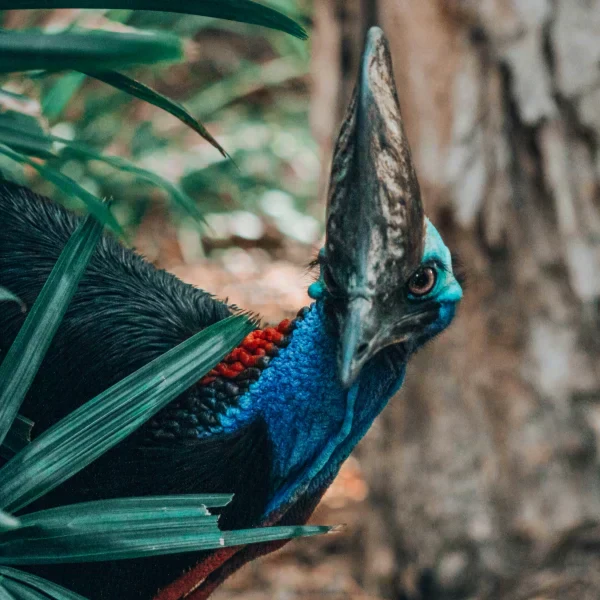Introduction
In our many years of living on Earth, we've come across many individuals who made us feel small. These individuals were either really tall, had a commanding voice, or a build that frightened us. All these are common descriptions of not just bullies or bouncers, but also a bird. It's time we talked about one of the world’s most dangerous birds: the cassowary.
Yes, this cassowary is as intimidating as it is fascinating. From a helmet-shaped casque, dagger-like claws, to a large, unreasonable build, it has it all. One unique fact is its ties to the prehistoric dinosaurs. So, today we’ll explore the cassowary’s survival strategies, its clashes with humans, why it’s seen as a menace in the jungle, and whether we should worry about it joining its dinosaur ancestors in extinction.

Photo by David Clode on Unsplash
Cassowary: The Dinosaur Bird of the Tropics
"Dinosaur bird" is not just a fancy nickname to match looks; the cassowary is actually the closest living relative of the prehistoric theropods – a group of lizard-like dinosaurs that boast incredible agility and speed.
The bird resides in the rainforests of Australia and New Guinea. Its key features include sharp claws, a helmet-like casque, and a strut fit for the runway of dinosaurs. In addition, the cassowary stands at 6 feet and weighs over 60kg, meaning it's not just other birds that get intimidated.

Species of the Cassowary Birds
There are three known species of the cassowary: the southern, northern, and dwarf cassowary.
Southern cassowary (Casuarius casuarius)
The southern cassowary is the largest and most popular of the cassowaries. It's also the second heaviest bird on Earth, compensating for its inability to fly with incredible speed. The bird is predominantly black with a mix of red and blue colorations on its face and neck. The females are heavier at 58kg, while the males weigh between 29 and 34kg.
Where do southern cassowaries live? They are mainly found in the tropical rainforests of northeastern Australia, particularly Queensland, as well as parts of Papua New Guinea and nearby islands.

Photo by Mikhail Nilov on Pexels
Northern cassowary(Casuarius unappendiculatus)
As for the northern cassowary, it's a massive unit that dwells in the swamps and rainforests of New Guinea. With a blue face, a helmet-like casque, and daggers for claws, it's a scary force of nature that shouldn't be provoked. It also measures up to 1.8m in height, and is quite a shy but solitary bird. Funny enough, females are polygamous, then each male cares for the chicks for around 9 months, and in some cases even longer.
Where do northern cassowaries live? The northern cassowary inhabits the lowland rainforests and swampy regions of northern New Guinea and nearby islands.

Dwarf cassowary(Casuarius bennetti)
Finally, the shortest of the pack – the dwarf cassowary – is the same as its brothers, just smaller. It measures between 99 and 150cm in height and weighs between 17 and 26 kg. The dwarf cassowary also possesses dagger-like claws and a casque shaped like a triangular helmet. These three species of cassowary, combined with the emu, all belong to the bird family Casuariidae.
Where do dwarf cassowaries live? This species prefers the mountain forests of New Guinea, New Britain, and Yapen Island, usually at higher elevations than the other cassowaries.

Cassowary Features: Beak, Feathers, And Helmet
The cassowary is undoubtedly a looker as its helmet-shaped casque immediately catches the eye. This helmet is made of keratin (the same substance our nails are made of), and could pass for a fashionable hood for birds. Debates are ongoing about its use. Is it used to amplify its sounds, regulate body temperature, or push through vegetation? For now, we're sticking with it being a bold fashion statement.

Photo by David Clode on Unsplash
When you're done admiring the out-of-pocket helmet, you're dazzled by its blend of hues on the face and neck. Deep and light shades of blue, including purple and red, make up the paint palette on the face, neck, and wattle. These distinct colorations are essential for identity and indicate health and age. Following this is a black plumage known for the long and coarse feathers that resemble horse hair.
Since the cassowary has no business in the sky, its feathers have been revamped into a glossy structure. This feather structure will provide extra protection from the rain, sun, and annoying branches.
Finishing off the unique avian design of a cassowary are the sturdy, athletic legs. Each reptile-like foot contains scales and three powerful toes, all bearing razor-sharp claws that reach up to 12cm – talk about dagger toes. But don't get too close because the cassowary packs a mean kick and won't hesitate to flex it on a potential threat.
Feeding Habits Of The Cassowary
You've heard of herbivores and carnivores, plus the omnivores who are a mix of both. But when it comes to the cassowary, the term frugivorous is the one that matches their food taste. Cassowaries are lovers of fruit, and they don't cherry-pick when eating. They eat any fruit from the really sweet, like mangoes, to the highly toxic, like the cassowary plum.
You'll mostly find these birds under fruit trees or rummaging through the floor for fallen fruit. Even big fruits like avocados and mangoes are swallowed when the cassowary is in the mood. This unorthodox feeding habit poses no problem for their digestive system, which is unique and fast. As a result, the cassowary can withstand toxic fruits and vegetable seeds and process them quickly enough to release large droppings packed with seeds.
However, the cassowary isn't limited, and if fruits aren't available, the cassowary switches to insects or will be found on the roadside searching for food.
Cassowary Habitat, Behavior, and Survival Skills
The cassowary is found in a variety of habitats, including rainforests, swamps, mangroves, and forests with layered vegetation. The animal is daring enough to live in conditions where other birds don't thrive, including swampy jungles and dense foliage. Given that this giant bird is a big introvert, a home with enough cover and camouflage is more than a dream.
But the solitary and elusive behavior of the cassowary takes nothing away from its active nature. The bird goes about its business during the day, patrolling and asserting its territory. At the same time, the cassowary patrols in search of food, such as fallen fruits, to munch on. This loop of commanding its territory and finding snacks continues for kilometers as these birds command a large area. But given the insane footing and athleticism of a cassowary, it's more than up to the task.

Photo by Matt Antonioli on Unsplash
With muscular legs and a leap of over 2 meters, this bird is also skilled at dealing with dense undergrowth. It's able to cover a lot of ground in no time, running at speeds of up to 50km/hr. The cassowary does this to protect its nest and ward off other birds from its mate. If you think the cassowary is unfairly gifted, then wait till you hear the cassowary swims pretty well, too, and with a claw rivalling daggers, defense is definitely not a problem. If anything, you're in safe hands with them as your bodyguard.
You could also send them undercover, as they move stealthily, which is surprising for their size. This stealth allows them to ambush or remain incognito, earning them the nickname of the ghost of the forest.

The Role Of Cassowary Birds In The Tropical Rainforest.
The relationship between a cassowary and its habitat is mutually beneficial. It's also a simple one – the first provides fresh, sweet fruits, while the cassowary returns the favor by dispersing seeds through its seed-packed poop. It's not the most elegant trade, but it helps preserve the lives of many tropical rainforests, and wherever the cassowary resides.

By Martin-rnr, via Wikimedia Commons, licensed under CC BY-SA 3.0.
Why the Cassowary Is Considered the World’s Most Dangerous Bird
Once again, it's essential not to be fooled by the shy and shun-in nature of the cassowary; this bird will attack if it feels the need to. Compared to other large flightless birds like emus and ostriches, the cassowary is considered far more dangerous. With its horn-like helmet, inner toe claws, and blistering speed, it isn’t a bird to provoke. There have been reported Cassowary attacks on humans. These were due to factors like habitat encroachment, defending their chicks, or provocations.
These events have earned the cassowary a ghastly but fitting reputation. Some go as far as to portray it as a lethal threat, while others see it as sacred. Most people have gone as far as attributing myths, including calling cassowaries rainforest guardians. But the moral of all stories remains the same: the cassowary is not a bird to be trifled with.
Incidentally, in the animal kingdom, some birds rely on powerful legs to survive, for example, the African Secretary Bird. Like the cassowary, the Secretary Bird has strong legs, but it mainly uses them to hunt snakes and small animals. Its temperament is relatively non-aggressive, posing almost no active threat to humans.

Endangerment Threats: Are We Slowly Losing The Cassowary?
While the dinosaurs have long vanished, the cassowary, their closest living relative, now faces threats from human activity. The emphasis is on "we" because humans are the most significant contributors to the dangers faced by cassowaries. For instance, urban development plans always include the destruction of habitats, rendering these birds homeless. According to the IUCN Red List, cassowaries are currently listed as Vulnerable, highlighting the urgency of conservation efforts.
Even careless driving that leads to road accidents has played its part in increasing worries about the cassowary. It's a series of events that starts with destroying the rainforests they live in, causing them to venture onto the streets to search for food, where they become victims of vehicle strikes. In other cases, dog bites and food shortages caused by invasive plants are huge threats to the dinosaurs of the jungle.

By I Love Trees, via Wikimedia Commons, licensed under CC BY 2.0.
Conclusion
A flightless yet intimidating bird, the black-feathered cassowary is proof that shy doesn't always mean meek. It's an active and territorial bird that's not afraid to get the claws out when on the attack or defense. An avid lover of fruits, it's also quick to dig into every piece of juicy fruit that falls off a tree, but won't spare the small animals or insects, or roadside trash when times get rough. Possessing a unique avian design, this is also a bird that attracts the gaze, so we too should try to appreciate rather than destroy their habitat.

FAQs About the Cassowary
Can a cassowary fly?
No, the cassowary doesn't fly as its wings are tailored for protection rather than flight. It does, however, run considerably fast, reaching 50km/hr, which more than makes up for its lack of flight.
Is the cassowary a dinosaur bird?
While the cassowary is not literally a dinosaur, it is often called a “dinosaur bird” because it belongs to a group of birds closely related to the extinct theropods. Alongside the emu, it shares many primitive features that reflect its evolutionary connection to these prehistoric lizards.
Are cassowary birds friendly?
The cassowary is a highly dangerous bird, equipped with strong feet and sharp claws reaching up to 12 cm in length. You should never provoke it, as it can deliver powerful kicks or claw strikes that can seriously injure you. It is also unsafe to approach them, especially if their space, food, or chicks are threatened, because they can become overly aggressive.
How powerful is a cassowary kick?
A cassowary kick is extremely powerful and potentially lethal. With strong, muscular legs and dagger-like inner toes, it can deliver a forceful strike capable of breaking bones or causing serious injury. This is one of the main reasons why people are advised to never approach or provoke a cassowary in the wild.
Who eats cassowary?
These birds are fearless and bold. However, they still have predators placed above them in the food chain! The only predators that cassowaries have are crocodiles, quolls, and dingos.




Leave a comment
All comments are moderated before being published.
This site is protected by hCaptcha and the hCaptcha Privacy Policy and Terms of Service apply.